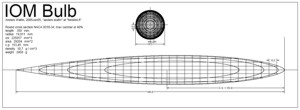
Since publishing the bulb mould plans there has been a couple of requests for a drawing of only the bulb. Here it is. It's a round cross section 350mm long NACA 0010-34 bulb.
I'm using a feature of Adobe Acrobat 6.0 to attach a DXF version to the PDF file. Open the PDF in acrobat reader and access the DXF by right-clicking on the paper-clip on the right and choose "save embedded file to disk".
Hi Anders! -And Congratulations with your new layout.! Together with München,Lester and a few more your site belongs to the main sources of documentation in IOMworld.
----------
About your bulb I´m just interested in your chooses regarding size and profile. I haven´t myself been able to find much infomation about the subject (Profile). What did happen to Youngs bodies f:ex.?
---------
Looking forward to hear more! (And also the foil to-do story!)
JOL
Hi Jens-Ole,
Thanks for the comments, I try to update as much as I can !
When designing the bulb we followed the golden rule of yacht design: If you don't know what to do - Copy the fast guys !
The NACA 0034-10 profile was conviniently available in the CAD program I use and looked very much like the bulbs on boats known to be fast. Those that know something about these seem to always refer to the low Reynolds numbers at which we operate - making research done with full-sized yachts in mind not so relevant for our scale. Model gliders operate closer to our Reynolds numbers so people have tried to learn IOM fin-design from the glider folks.
If you're serious about doing some homework then a trip to the library, looking up all issues of Seahorse with articles by David Hollom, is recommended. I understand he has designed the SailsETC foils.
For the foil story I was just planning on documenting the fin planforms that seem to be popular today and something about the 85 mm chord 6% NACA fin we've been producing locally.
Anders
What is the total wetted surface of that type of bulb?
Hi Todd,
take a close look at the pdf, it says area 29204 mm^2 and if I remember correctly that is the total surface area of the bulb.
Choosing the length of the bulb is obviously a trade-off between form-drag, mainly associated with the transverse profile or diameter of the bulb, and surface-drag which depends on the wetted area.
For some reason at IOM Reynolds numbers it seems like thinner and longer bulbs are more popular than on fullsize yachts. If you or someone else can explain this well then I'm all ears!